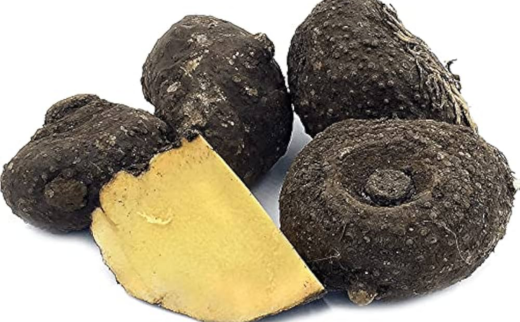Suran/ Elephant Foot Yam/ Amorphophallus campanulatus Blume – Ayurvedic Uses & Benefits
Abstract
Amorphophallus campanulatus, commonly known as Surana in Sanskrit and Elephant Foot Yam in English, is a stout, tuberous herb (corm) belonging to the family Araceae. In Ayurveda, it is highly valued for its therapeutic applications. According to Acharya Vagbhata in the Ashtanga Hridaya, it is listed under Agrya Dravya, making it the foremost herb for treating Arsha (haemorrhoids). Surana is widely used in managing various health conditions, including Ashtila (enlarged prostate). Traditionally, the corm is consumed in the form of curries and pickles and is recommended in disorders involving vitiated Vata and Kapha doshas. Traditionally, it is processed and used to treat piles, abdominal disorders, and respiratory issues.

Introduction
Amorphophallus campanulatus belongs to the Araceae family and is extensively used in Ayurvedic medicine for its pungent, heating, and stimulating qualities. The plant is cultivated in various parts of India and Southeast Asia, primarily for its large underground corm. The therapeutic potential of the tuber is enhanced after purification (shodhana) to reduce its natural acridity. It is beneficial in conditions such as arthralgia, elephantiasis, tumours, inflammation, bleeding disorders, vomiting, cough, bronchitis, asthma, anorexia, indigestion, flatulence, colic, constipation, worm infestations, liver and spleen disorders, amenorrhea, dysmenorrhea, seminal weakness, fatigue, anaemia and general debility. Modern studies support its pharmacological actions, aligning well with its traditional uses.
Scientific Classification
- Kingdom – Plantae
- Clade – Angiosperms
- Order – Alismatales
- Family – Araceae
- Genus – Amorphophallus
- Species – Amorphophallus campanulatus Roxb.
Synonyms
- Surana – “Suryate Isyate Arshaple Gulma Cha Visha Dadaanane Ithi” – Effective in treating piles and abdominal tumours.
- Arshoghna – One that cures Arsha (piles).
- Kandula, Kandanayaka – Considered the best among tuberous plants.
- Vatari – Cures diseases caused by Vata Dosha.
- Sthulakande – Refers to the large size of the tuber.
- Rucyakanda – The tuber is palatable and tasty.
- Durnamaree – Effective specifically in treating piles.
- Teevrakanda – Denotes the strong potency of the tuber.
- Vanodbhava – Naturally grows in forests.
- Chitradanda
- Kandi
- Kandasurana
- Ullo
- Samasteela
Vernacular Names
- Hindi name – Suran, Jamikand, Surankand, Suran Kand
- English name – Elephant foot yam, Elephant yam, Stanley’s water-tub, Konjac
- Bengali name – Ol
- Gujarati name – Suran
- Marathi name – Suran
- Kannada name – Suvarnagadde
- Malayalam name – Chena
- Tamil name – Karynai kilamku, Chenaikkirangu
- Telugu name – Kandagadde
Habitat
Amorphophallus campanulatus, commonly known as Elephant Foot Yam, is a tropical tuberous plant native to Southeast Asia, with India and Sri Lanka being primary regions of cultivation. It thrives in warm, humid climates and is well-suited to loamy or sandy-loam soils with proper drainage. The plant is typically cultivated during the monsoon season and harvested after 7 to 8 months of growth. Widely grown across the plains of India, it is found both in cultivated farms and in the wild, particularly in forested and semi-wild rural areas. Its hardy nature and low maintenance make it a popular choice in backyard gardens and traditional agricultural systems.
Morphology
Amorphophallus campanulatus is a stout herbaceous plant characterised by a large underground tuber or corm, which is depressed, bulbiferous and typically measures 20–25 cm in diameter with a dull brown exterior. The plant generally bears one to two large, solitary leaves ranging from 30–90 cm, with broad, simple or forked segments. The leaflets are oblong and acute, and the petiole is dark green with pale blotches. The inflorescence emerges on a peduncle that elongates with fruiting and features linear-oblong sheaths. The spathe is orbicular to ovate, measuring 15–23 cm across, and has a fleshy texture with colouration that commonly varies green with white spots on the lower surface and greenish-purple or rough dark purple within. The spadix is very stout, with a cylindrical female portion, a sub-turbinate male part and a dark purple appendage that can reach up to 15 cm in diameter.
Varieties
There is another variety of Suran which is found mainly in Mumbai, ie, Var. blumei Prain. Suran is considered the best among the varieties of rhizomes.
Classical Categorisation
- According to Bhavaprakash Nighantu – Shaka Varga (group of vegetables)
- According to Kaiyadeva Nighantu – Aushadhi Varga (group of medicinal herbs)
- According to Raj Nighantu – Moolakadi Varga (group of tuberous root plants)
Ancient Verses
सूरणो दीपनो रूक्षः कषायः कण्डुकृत् कटुः ॥
विष्टम्भी विशदो रुच्यः कफार्शः कृन्तनो लघुः ।
विशेषादर्शसे पथ्यः प्लीहगुल्मविनाशनः ॥
सर्वेषां कन्दशाकानां सूरणः श्रेष्ठ उच्यते ।
दद्रूणां कुष्ठिनां रक्तपित्तिनां न हितो हि सः ।
(Bhavprakash Nighantu Shaak varga 91-93)
According to the above shloka, Suran has a pungent and astringent taste, dry nature and contains cleansing and appetising properties. It is effective in the management of digestive fire, haemorrhoids and tumours in the abdomen. It causes itching and constipation, and balances Kapha dosha.
Suran is considered the best in the category of tubers, but it is not suggested in case of bleeding disorders, ringworms and leprosy.
Ayurvedic Properties
- Taste (Rasa) – Astringent (Kashaya), Pungent (Katu)
- Physical property (Guna) – Light (Laghu), Dry (Ruksha)
- Potency (Veerya) – Hot Potency (Usna)
- Post-digestion effect (Vipaka) – Katu (Pungent)
- Effect on tridosha – Balance Vata and Kapha dosha
Therapeutic Properties
- Deepana (Appetiser)
- Pachana (Digestive)
- Lekhana (Scraping)
- Arshoghna (Anti-hemorrhoidal)
- Medohara (Anti-obesity)
- Vata-Kaphahara (Pacifies Vata and Kapha)
- Shothahara (Anti-inflammatory)
- Krimighna (Anthelmintic)
Systemic Actions
- External Use – Acts as an analgesic and anti-inflammatory agent. The external application of its paste mixed with honey or ghee is beneficial in conditions like joint inflammation, elephantiasis, and abnormal tissue growth.
Internal Uses
- Digestive System – Possesses carminative, liver-stimulating, antispasmodic, and anthelmintic properties. Aids in regulating the movement of doshas and supports healthy liver function. Beneficial in conditions like haemorrhoids by helping to shrink the pile mass. Also indicated in anorexia, loss of appetite, constipation, gulma (abdominal tumours), and Kapha-Vata type of piles. Excessive intake may cause gastric discomfort and abdominal bloating.
- Respiratory System – Helps pacify Kapha dosha. Indicated in conditions like cough and respiratory disorders.
- Reproductive System – The root tuber acts as an aphrodisiac and is beneficial in managing oligomenorrhea (scanty menstruation).
- Satmikarana – Acts as a Balya (strength promoter) and Rasayana (rejuvenative). Useful in treating general weakness and debility.
Chemical Composition
- Diastatic enzyme: Amylase
- Betulinic acid
- Tricontane
- Lupeol
- Stigmasterol
- Beta-sitosterol and its palmitate
- Sugars: Glucose, Galactose, Rhamnose, Xylose
- Calcium oxalate
Modern Overview
Effect on Haemorrhoids
Suran (Amorphophallus campanulatus), commonly known as elephant foot yam, contains several bioactive phytochemicals such as betulinic acid, β-sitosterol, lupeol and flavonoids. These compounds possess significant anti-inflammatory, antioxidant and venotonic properties. Betulinic acid and β-sitosterol inhibit pro-inflammatory mediators like COX-2 and TNF-α, helping to reduce inflammation, pain and swelling associated with haemorrhoids (piles). Additionally, their antioxidant action helps protect rectal tissues from oxidative damage, promoting healing. These effects collectively make Suran beneficial in the management of internal and external haemorrhoids.
Additionally, Suran (Amorphophallus campanulatus) is a rich source of dietary fiber, which plays a vital role in managing piles (haemorrhoids). The fiber content helps in softening the stool and increasing its bulk, thereby promoting smoother bowel movements and reducing constipation-related straining, a major cause of hemorrhoidal swelling. Regular intake of Suran can help maintain colon health, prevent hard stools and minimise pressure on the rectal veins, thus alleviating discomfort and supporting long-term management of piles.
Practical Uses
- A paste made from the tuber of Surana mixed with ghee is applied externally on the legs affected by elephantiasis and joint swelling.
- The juice of Surana Kanda is taken in a dose of 10 ml to help manage piles, intestinal worms, indigestion, and hepatomegaly.
- Boiled tuber of Amorphophallus campanulatus is consumed in a dose of 15–20 g to treat amenorrhea.
- A cold infusion of the tuber is given in a dose of 15–20 ml to relieve cough and asthma.
- Dried powder of the tuber is mixed with buttermilk and taken in a dose of 3–4 g to manage haemorrhoids and piles.
- The tuber is coated with mud, sun-dried, and then burnt; the resulting ash is consumed in a dose of 5–6 g to treat internal growths like tumours.
- Surana is widely used as a vegetable in various cuisines around the world.
- In the treatment of Arshas (piles), Surana is considered an effective anti-hemorrhoidal herb, especially beneficial in piles caused by Kapha-Vata dosha.
Part Used
Tuber
Dosage
Powder – 1–3 gm
Ayurvedic Medicines
- Suran Vatak
Planet Ayurveda Medicines
Conclusion
Amorphophallus campanulatus is more than a culinary tuber; it is a powerful Ayurvedic herb with multipurpose medicinal benefits. With its ability to enhance digestion, relieve inflammation and aid metabolic balance, it holds a respected place in traditional and modern therapeutic systems. However, due to its acrid nature in raw form, it must be properly prepared before use. This humble yet potent tuber continues to serve both as a food and a healer in the Ayurvedic pharmacopoeia.



